How to Dehydrate Carrots (Homemade Carrot Chips)
Dehydrating carrots may be easier than you think it is. If you have a dehydrator, you can use it. And if you don’t, you can do it in your oven. This recipe will give you simple, step-by-step instructions on how to dehydrate carrots using a dehydrator or an oven.
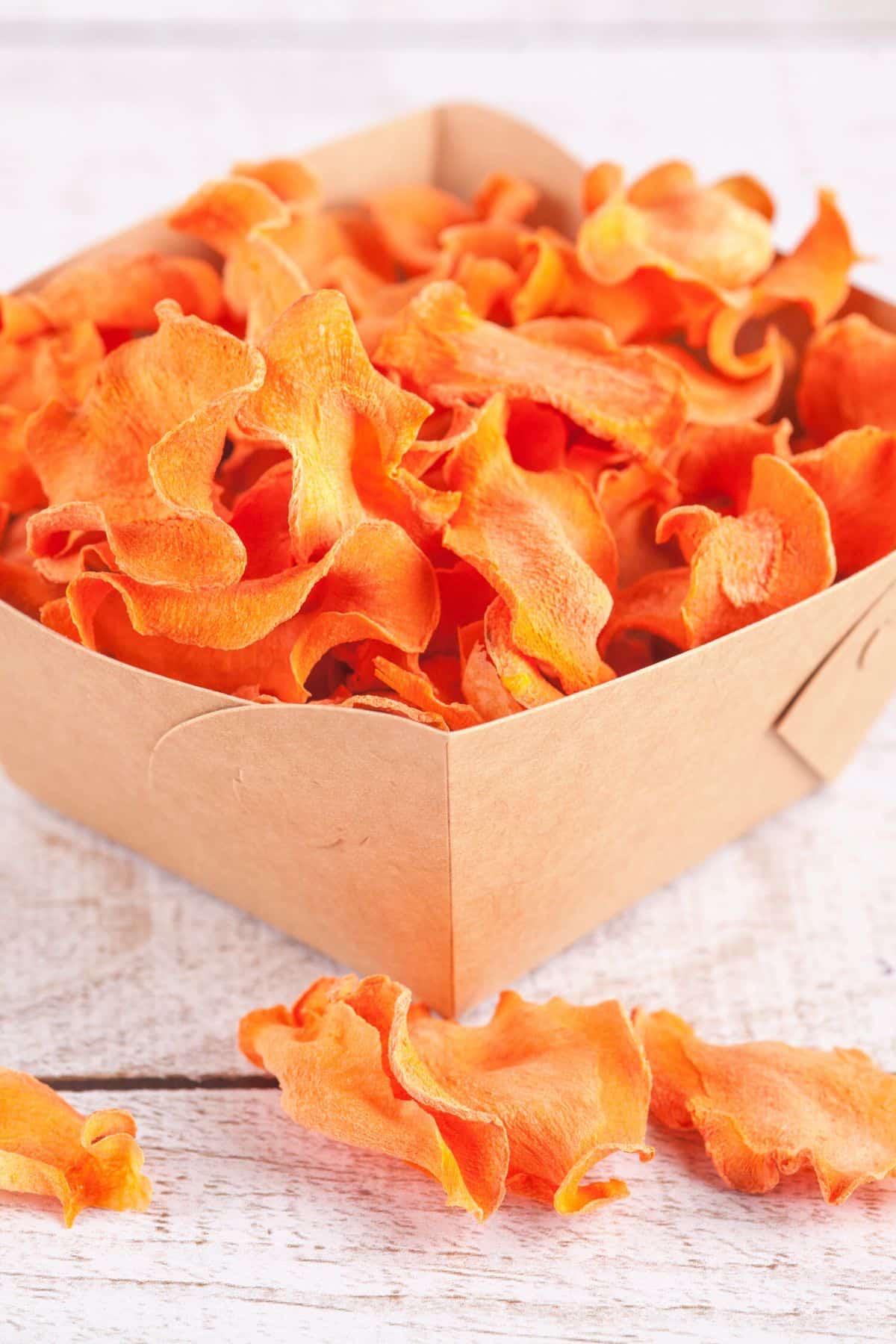
If you’ve ever wondered how to dehydrate carrots, you’re in luck! This article will give you all the steps you need to turn fresh carrots into dehydrated carrots that you can store indefinitely, ready to be rehydrated for your recipes.
You can use them for soups, stews, casseroles, juices, and more. One of my favorite ways to use rehydrated carrots is making these tasty (and healthy!) carrot crackers. They’re delicious with hummus!
If you have more carrots than ideas of what to do with them, dehydrating is an excellent solution. It’s an inexpensive way to preserve these healthy veggies indefinitely.
You’ll be amazed at how useful dehydrated carrots are as a pantry staple. You can rehydrate them in a flash and use them in a massive variety of recipes.
Why You Need This Recipe
- Whipping up a tasty stew, soup, or casserole is easy if you have dehydrated veggies like carrots in your pantry.
- If you’re a camper or long-distance hiker, dehydrated carrots are an excellent food for adventures in the great outdoors. They’re lightweight and packed with nutrients.
- Dehydrated carrots take up very little storage space. They’re much less bulky than fresh, canned, or frozen carrots. So, if you have limited space, they’re ideal.
What You’ll Need to Make This Recipe
You’ll only need basic equipment that most kitchens will have to dehydrate carrots. Here’s a list of what you’ll need and some alternatives if you don’t have an item.
1. A Dehydrator or Oven
If you don’t have a dehydrator and plan to dehydrate food regularly, it may be worth investing in a dehydrator. If not, you can use your oven; it will also work.
2. Large Cooking Pot
You’ll use the pot to blanch your carrots, so it should be large enough to contain all the carrots you want to dehydrate.
If you don’t have a large cooking pot, that’s okay; you can blanch your carrots in a smaller pot in batches. It will just take a little longer.
3. A Colander or Slotted Spoon
You don’t have to have a colander, but it makes it easier to blanch your carrots. You can use it to hold the carrots as you immerse them in the boiling water and then in the ice water.
If you don’t have a colander, you can use a slotted spoon to move the carrots across.
4. Storage Containers
You can store dehydrated carrots in an airtight container, as long as it keeps them from moisture or humidity. Glass containers work well but can be bulky.
You can use Ziploc bags if you have limited storage space or want to take your carrots on a camping trip.
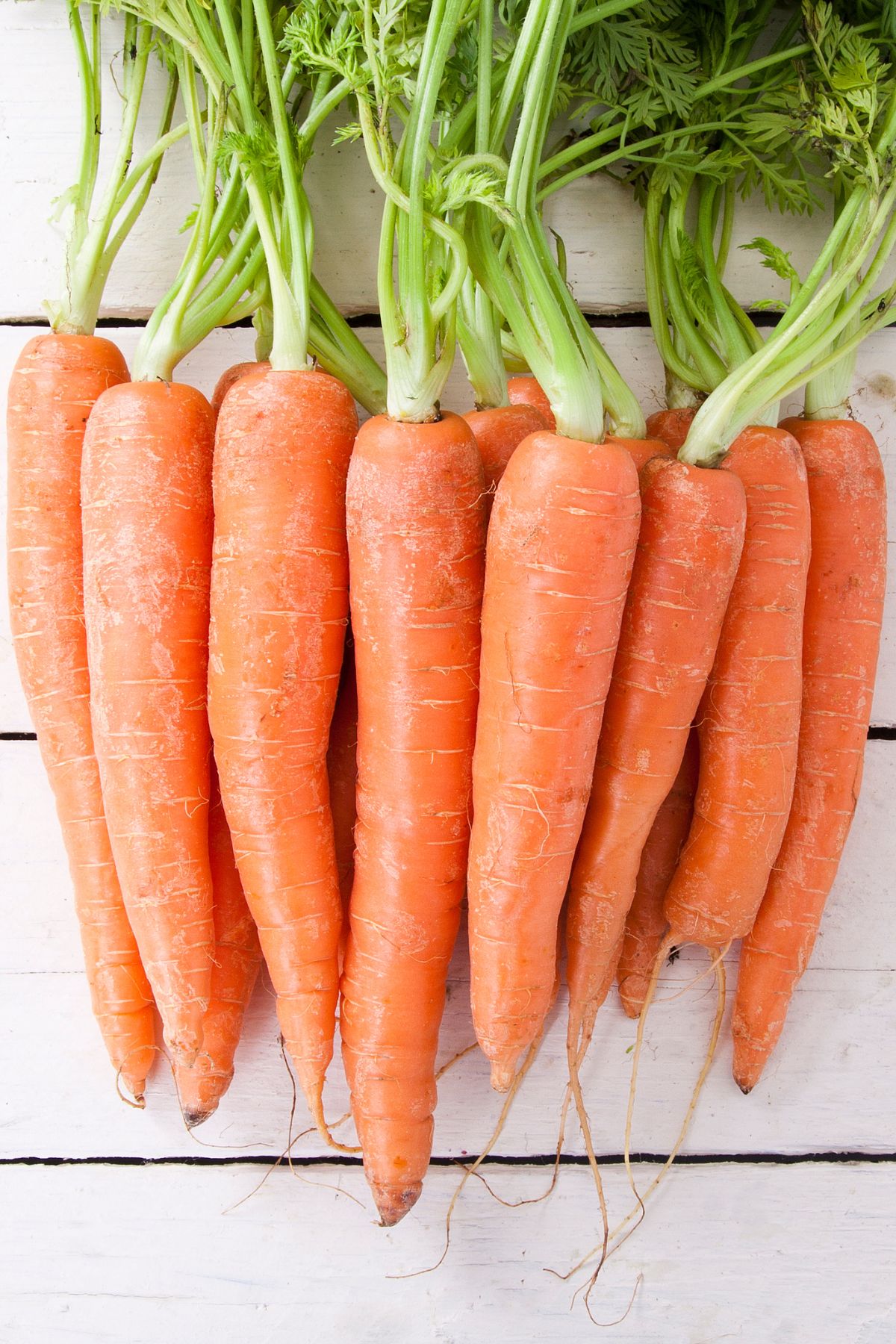
Ingredients and Substitutes
Dehydrating carrots is easy! You won’t need any additives or hard-to-find ingredients.
Carrots
The better the quality of the carrot is, the better your results will be. To choose the best carrots to dehydrate, try to select carrots with their leaves attached.
Crisp, vibrant leaves are a sure sign of a fresh carrot. Look for firm, deeply colored, long carrots if they no longer have leaves attached.
Fresh carrots are firm to touch; if they’re squishy, they’ve already started losing some valuable nutrients. Deeply colored carrots are also a sign of freshness.
The longer the carrots are, the better! The longer they stay underground, the more they grow and the sweeter they become.
You can use baby carrots, but regular carrots are ideal.
Ice Cubes
You’ll need a few ice cubes to cool the water down for the ice bath.
Recipe Steps
Step One
Wash your raw carrots well and remove any soil from them. Peel the carrots and trim the carrot tops.
Cut the carrots into small slices around a ¼ inch thick.
You can also use a mandoline slicer or a food processor fitted with the slicing disk.
Step Two
Bring a large cooking pot filled with water to a boil. Fill a large mixing bowl with cold water and some ice while you wait for the water to boil.
Step Three
Lower your carrots into the boiling water. Leave the carrots in the boiling water for two minutes. They should be bright orange and still crunchy.
Step Four
Remove the carrots from the boiling water and immerse them in the ice bath until they’re completely cool.
Drain and pat the carrots dry using a clean kitchen towel or paper towel.
Step Five
Turn your dehydrator on and set it up according to the user manual.
Lay the carrot slices carefully onto the dehydrator trays, making sure they’re in a single layer.
Place the carrots on the sheets into the dehydrator for 6-8 hours. The drying time will vary depending on how thick or thin you slice or cut your carrots.
Step Six
Turn the dehydrator off and allow the carrots to cool completely. Store your dried carrots in an airtight container like mason jars for long-term food storage. Or, feel free to grind the dried carrots into carrot powder to add to meatballs, smoothies, breads, or whatever you like.
Ideally, keep your dehydrated food in a dark place out of direct sunlight.
You can also make dehydrated carrot strips as opposed to chips if you like. The instructions remain the same, just slice the carrots into strips instead of rounds.
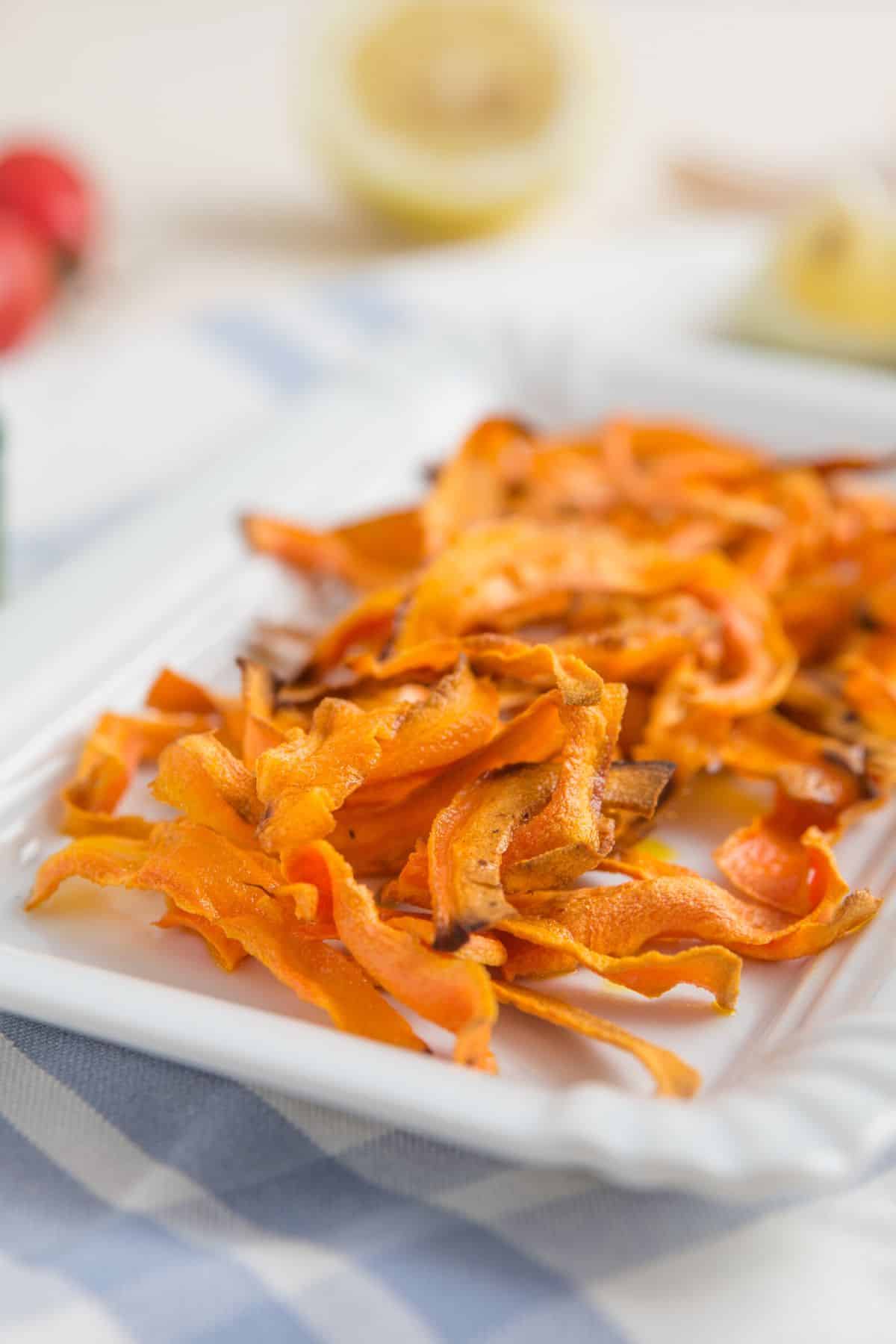
Don’t Miss These Carrot Recipes!
Recipe FAQs
Dehydrating carrots is one of the top ways to preserve them. You could also pickle, can, or freeze carrots, but dehydrating them has tons of benefits! It takes up less storage space, makes it easy to take carrots on an outdoor adventure, and leaves the original flavor without added sugar, salt, or vinegar.
Almost! Although some nutrients are lost when you blanch the carrots, dehydration locks in the rest of the nutritional value. Dehydrated carrots are still an excellent source of vitamin A, several B vitamins, vitamin K, antioxidants, potassium, and of course, beta-carotene, which can help lower the risk of cancer.
Almost anything you’d use fresh carrots for! Once you’ve rehydrated, one cup of dehydrated carrots turns into around two cups of carrots.
You can use these sweet and tasty veggies in stews, pasta sauces, soups, casseroles, or baking. Dehydrated carrots also work well in juices and in baked goods like carrot cake and muffins.
Blanching is part of getting your carrots ready to be dehydrated. It protects the carrots from losing color, flavor, and texture.
Although it may seem unnecessary because the idea is to get liquid out of the carrots and not add more in, blanching makes dehydration go faster! When you submerse the carrots in boiling water, they release some of their juices which help the dehydration process.
More Dehydrator Recipes You Might Like
I hope you make this recipe! If you do, please leave a comment and a starred review below.
And, consider following me on social media so we can stay connected. I’m on Facebook, Pinterest, Instagram, and YouTube!
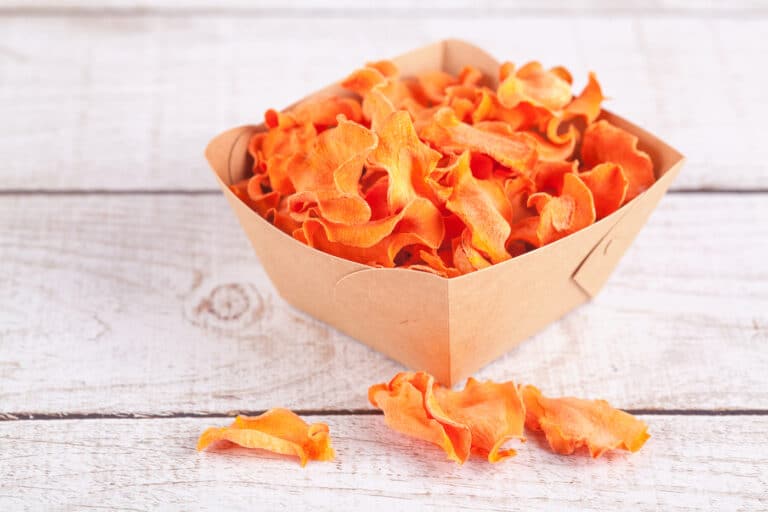
How to Dehydrate Carrots (Homemade Carrot Chips)
Now that you’ve locked the flavor and color in nicely, it’s time to dehydrate your carrots and prepare them for storage. You can do this with a dehydrator or an oven. Here are the two methods.
- Total Time: 8 hours 12 minutes
- Yield: 24 servings
Ingredients
- 5 pounds carrots
Instructions
- Wash your carrots well and remove any soil from them.
- Peel the carrots and trim the tops. Cut the carrots into small slices around a ¼ inch thick.
- Bring a large cooking pot filled with water to a boil.
- Fill a large mixing bowl with cold water and some ice while you wait for the water to boil.
- Lower your carrots into the boiling water. Leave the carrots in the boiling water for two minutes. They should be bright orange and still crunchy.
- Remove the carrots from the boiling water and immerse them in the ice bath until they’re completely cool.
- Drain and pat the carrots dry.
- Turn your dehydrator on and set it up according to the user manual.
- Lay the carrot slices carefully onto the dehydrator sheets, making sure they’re in a single layer.
- Place the carrots on the sheets into the dehydrator for 6 to 8 hours.
- Turn the dehydrator off and allow the carrots to cool completely. Store your dehydrated carrots in an airtight container.
Notes
- Oven method: Blanch the carrots as per the instructions above. Preheat your oven to 125°F. Lay your carrot slices onto a baking sheet in a single layer. Place the sheet into the oven for 8 to 10 hours. Check the carrots after 6 hours and again after 8 hours to see if they’re dry. Rotate the tray if necessary. Once they’re dry, allow the carrots to cool completely. Store your dehydrated carrots in an airtight container.
- You can dehydrate any amount of carrots, it doesn’t have to be in 5 pound batches. If you dehydrate a larger amount, just make sure you have enough space in your oven or dehydrator; otherwise you will have to dry them in batches.
- Carrots should be hard and crunchy when they’re dehydrated. To test them, squeeze a piece with your fingers. It should be hard and break, not bend. If it’s soft or bendy, or you see any moisture, the carrots need to be dehydrated a little longer.
- You can grind the dehydrated carrots into powder to sneak them into sauces, soups, stews, and smoothies.
- Rehydrate dried carrots by adding 2 cups of boiling water to each cup of dehydrated carrots and allowing it to stand for 1 to 2 hours.
- Prep Time: 12 minutes
- Cook Time: 8 hours
- Category: Side Dish
- Method: Dehydrator
- Cuisine: Healthy
- Diet: Vegetarian
Nutrition
- Serving Size: 1/24 of recipe
- Calories: 39
- Sugar: 4.5 g
- Sodium: 65.2 mg
- Fat: 0.2 g
- Saturated Fat: 0 g
- Carbohydrates: 9.1 g
- Fiber: 2.6 g
- Protein: 0.9 g
- Cholesterol: 0 mg
Don’t forget to join my newsletter list to get exclusive clean eating recipes and tips. The newsletter is 100% free with no spam; unsubscribe anytime.
About the Author: Carrie Forrest has a master’s degree in public health with a specialty in nutrition and is a certified holistic nutritionist. She is a top wellness and food blogger with over 5 million annual visitors to her site. Carrie has an incredible story of recovery from chronic illness and is passionate about helping other women transform their health. Send her a message through her contact form.




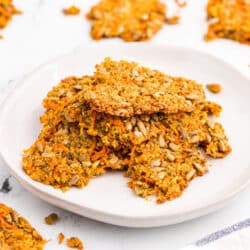

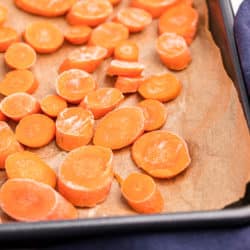
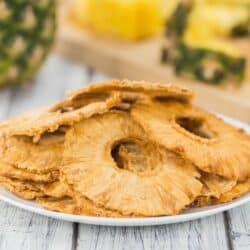
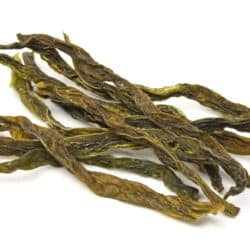
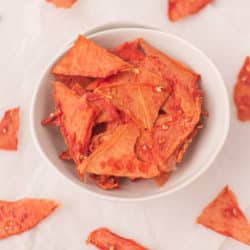
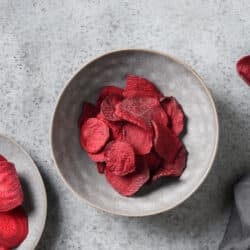


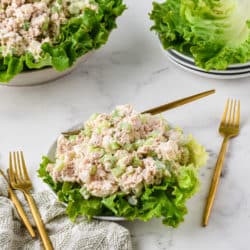
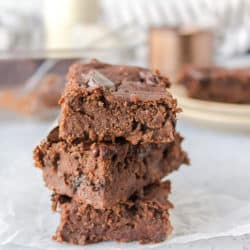

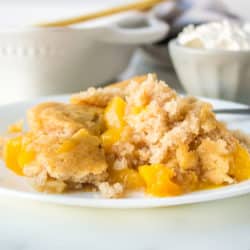








Such a fun and satisfying activity to preserve foods like these yummy carrots.